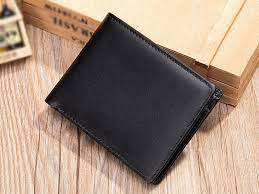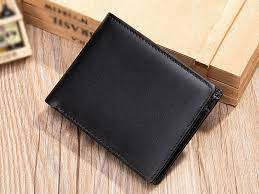
The wallet, as you know, has been around for hundreds of years. Why hasn’t it changed much? Your wallet can do more. You might still need to learn about many ways to use a wallet today. Read on to learn more about the wallet’s history, where it is now, and how to use it in various situations.
History of Wallet
It comes from the Old Norse word walata, which means to cover or shield. This is because people used wallets in the past to keep their money safe. In the Middle Ages, people carried coins in a leather pouch around their waist or neck. In the 10th century AD, the Duke of Normandy was thought to have been the first to use it.

Europe in the 17th century became an important part of a man’s wardrobe and started to look like the ones we use today. Some men wrapped them around their waists, while others hooked them to belts or pants. No matter how they wore them, they had pockets with different compartments for things like carrying receipts, checks, and coins.
Men and women around the world still carry them. Still, they come in many different sizes and shapes depending on what you want to put in them, such as cards, cash, business cards, or even your driver’s licence. They also come in various materials, like plastic, metal, and fabric so that you can find the right style for you. Modern wallets also have a lot of special features, like RFID-blocking technology that keeps people from scanning your credit card details without your permission.
The Early Days of the Wallet
Before wallets were made, people carried around purses. Most of the time, these purses had an opening on one side that was closed with a drawstring. This made it easy for a woman to throw them over her shoulder. Men usually carried their money in a small bag that hung from their belts at this time.
When men started putting coins in their pockets instead of purses, purses became less popular. Ultimately, this led to the wallets that men and women use today. They are different from purses because they have slots for credit cards and larger spaces for cash. It’s for women are usually smaller than those men because women tend to carry less with them.
The biggest difference between then and now is that people no longer keep coins or other things in their wallets. Now, most people only use their wallets to store cash and cards. You can get a large bi-fold or a slim one, depending on how much space you need. If you put your hands in your pockets a lot and want to avoid pulling out your it every time you want to pay for something, you should get bifold.
Slim wallets are better if you want something that isn’t too big but still holds everything you need without being too bulky. They are also great if you only sometimes pull out your wallet. Before buying any kind of it, you should consider what kind of fabric it is made of. Polyurethane wallets will last longer than leather wallets and won’t lose their colour as quickly. Since there are so many choices, it should be easy to choose a new wallet.
Different types of wallet
-its are often constructed out of leather, fabric, or plastic. Leather wallets can be quite sturdy, but they may not be as flexible as a cloth wallets. Plastic wallets are less expensive than leather or fabric alternatives. Still, they also tend to shatter more easily if dropped or otherwise mistreated.
Your banknotes stay put in your wallet while you reach for your coins when you pay with cash.
–
You may find it in whatever size or shape you choose today, so you can pick one that perfectly reflects your individuality. For example, someone who is always on the go might want a smaller one, while someone who likes to carry around plenty of cards will want a larger one. Some individuals like the extra space that comes with a bi-fold. In contrast, others prefer a slimmer style that is easier to carry around. Some have room for a few credit cards. In contrast, others feature sections for identification cards, business cards, and even photos. Coin pockets at its rear offer a handy place to stow spare change without cluttering the primary storage area.
The Rise of the Bifold
A new type of wallet appeared in the year 1860. As its successor, the skinfold, the bi-fold design was a huge advance over the older trifold format. A bi-fold is still widely used and is widely believed to be the most common style carried by men and women today.

Bifolds have evolved through synthetic materials like Tyvek and plastic instead of leather. People’s desire to transport less cash resulted in a slimming of these instruments. However, this presents a challenge for those who, for practical reasons, want to store more than just their cards in their wallets. The foldover, whose two flaps fold together to form a closure, is another popular style. The front pocket’s double-wide design makes storing and retrieving items convenient without opening them each time. The front pocket becomes useless if you only need one card when using this type, which is a major drawback.
On the other hand, this could be ideal for you if you’re constantly on the go and need to keep track of multiple items, such as keys, cash, and a phone. Several hybrids in its designs are also available, combining elements of different wallet styles, such as bi-folds and within. It can take time to choose the ideal one for your needs among the wide variety available.
The Trifold Comes Into Play
Around this time, a man named George Chase got a patent for a folding wallet to keep its contents safe. On November 12, 1891, the patent was given.
Unfortunately, he needed help finding a company to make them, so production has yet to start. He then showed his idea to New York and Chicago businesses, but it didn’t catch up. Chase didn’t give up and tried again because of that. In 1904, he made another design for a leather-bound wallet with three panels that could be folded together like a book or opened flat like a box.

This style became popular because it was easy to carry in a pocket or purse. At first, men were the only ones who used it. But as more women went to work during World War II and started carrying purses to hold their daily needs, it became a must-have for both men and women. We carry credit cards, debit cards, ID cards, health insurance cards, and photos of our loved ones in our wallets. And the triple fold of today is thinner than it has ever been. Companies that make credit cards have started making cards the same size as credit cards and fit right into the folds.
It’s hard to imagine how people lived without such a useful tool back then, especially since you can use it often without even realising it. Also, a wallet is one of the most important things to bring abroad. Suppose you need to know what currency a store takes. They’ll probably give you the equivalent amount of money if they don’t take foreign credit cards (or they may not let you buy anything at all). If you don’t have Euros, someone who wants to buy something that costs $3 might only be able to pay €2. But if they have it full of Euros, they’ll only need some coins from their home country (which can come in handy if they’re running low on Euros), and everything will be fine.
The Modern Day it
Wallets come in a variety of sizes and shapes today. Card-only its are ideal for persons who wish to maintain a low profile. Additionally, there are bifold wallets with two panels that allow you to hold more cash, cards, or both. Nevertheless, purchasing one that will fit properly in your pockets or purse is essential! You should consider purchasing a large wallet if you frequently carry multiple credit cards and cash. If convenience is of the utmost importance, look for a compartment with easy access, such as one on the exterior, so you can access your credit cards without having to open the entire wallet. These divisions are fantastic since they make it easy to find what you need without rummaging through everything. The ID window is another compartment to consider when purchasing a new wallet. I strongly endorse this feature as someone whose ID has been stolen by pickpockets!

Tips on picking the perfect wallet
If you want the best wallet for your needs, there are a few factors to remember.
-How much money do you have to work with? When shopping for a wallet, your budget should be your top priority. Wallets come in various styles, materials, and brands. They can cost anywhere from free to hundreds of dollars. Choose the more affordable option if you need to figure out how much you want to spend.
Tell me about the things you buy with your wallet. When shopping for a wallet, it’s crucial to consider how you’ll utilise it. A pocket or wristlet wallet may suffice if you only need a few dollars and cards. However, a larger wallet will be more convenient and safe if you carry a lot of cash or credit cards.
You’ve got to tell me, what kind of person are you? Are you someone who values efficiency and order? Wallets can be carried in the front or back pocket; some prefer the former for convenient access, while others choose the latter for their stealth.
What part of your body do you carry your wallet? Your chest or your waist? When shopping for a wallet, it’s crucial to consider where it will be carried (on the chest or the waist).
Where to put your cash and why
Money is something that many individuals like to keep in physical form. However, some also use digital methods. However, that is only sometimes the greatest approach. A better way to keep your money is described here.
-Only put all your money in the account you use for your regular bills and purchases; instead, open a second account that you’ll use for savings. The more you can put away now, the safer your financial future will be.
-Keep your spending in check: If you want to be a good steward of your money, you must monitor your spending habits often. You can do this in several ways, one of which is to keep a monthly budget and adhere to it religiously. As a result, you’ll be able to keep your spending within the limits you’ve set for yourself.
Many people prefer plastic cards over paper bills because they are more convenient and less susceptible to fraud or theft. Furthermore, plastic cards offer a higher level of security when storing sensitive information like bank account numbers and personal identification numbers.
Making sure you have some cash put away for times when you need it isn’t exactly the most riveting of topics, but it’s crucial all the same. Things like car repairs and emergency medical care are examples of this. Having this kind of emotional reserve will allow you to deal with challenging events without
How Wallets Are Used Today
We put money, credit cards, ID cards, and other important things in our wallets. Most of the time, we keep them in our back pockets or purses. Wallets come in all shapes and sizes, depending on what we need to carry.
Some people have bigger ones with extra spaces like pens, chequebooks, keys, etc. Some people like ones that are small enough to fit in their pockets. They are made of different materials, like leather or fake leather. Some of them have zippers, and others don’t. One could be made just for men, while another for women.
The most common kinds of its are bi-fold and tri-fold, but there are many different ways to make each. Most bi-fold wallets open like a book, but some fold out, so they’re flat. Most trifold wallets open up to make one long side with three flaps to hide your cash and cards. When they sit down, many people who wear jeans put an elastic band around their wallet, so it doesn’t fall out.

A bifold wallet works well because it fits well in any size front or back pocket. People will sometimes use a wristlet to carry their cash and phone simultaneously. You can also put a wristlet on your purse strap, which is another great thing about them. But many purses these days don’t have straps so you can attach these to the outside of the bag instead. Most purses without straps have small pockets where you can put things like your phone, sunglasses, chapstick, or snacks. You’ll also see wallet with lanyard chains at events or festivals where there’s no place to put anything down because you’ll be holding everything in your hands anyway.











